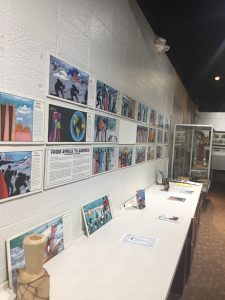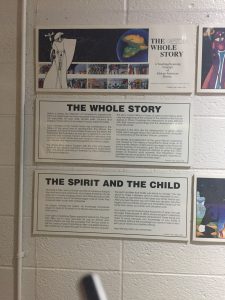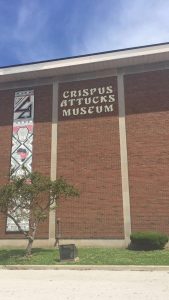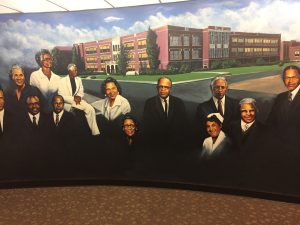by Dominique Harrington
The Indiana Public School (IPS) Crispus Attucks Museum, a museum which commemorates the first black high school in Indianapolis, was founded in 1998 to preserve the school’s rich history. Despite being next to the Crispus Attucks High School’s gym and auditorium, I never noticed that the museum was there. The museum is attached to the school, on its south side, closest to the sporting fields. Equipped with my phone to take pictures, a pen, and my notebook, I walked up to the door of the museum.
The exterior of the museum features this painting that places Crispus Attucks, with the “CA” at the top, with a grander narrative of African and African-American history as displayed through the African imagery present.
I walked into the museum, which is one large room, organized chronologically, with different themes–international, national, and local–organizing it. Despite the museum’s relatively small size, one can tell that the curators tried their hardest to be both deliberate and thorough with their design of the museum and even the text of the labels. When I came to this museum, I thought that it would be dedicated to sharing the history of the high school, named after the first person killed in the Revolutionary War, a black man, Crispus Attucks. I was only partially correct because the museum attempts to tell not only the story of Crispus Attucks High School, but the story of black folks in this country as well.
This is what meets the visitor’s eye right when they walk into the museum.
This mural includes influential administrators and teachers throughout the school’s history. To me, it exudes overwhelming pride. It sets the tone for the rest of the museum by saying that these were the ones who came before us. These are the ones who paved the way, and these are the ones we honor. Whether it’s the trailblazers from Crispus Attucks, or black folks integral to the city, like Madame CJ Walker, the museum encourages visitors to reflect on the resilience and accomplishments of a people with all odds stacked against them, tracing the history of African civilizations, continuing with the Era of American Slavery, and then with the Civil Rights Movement.
I enjoyed my time perusing the exhibits and looking at the artifacts, from hot combs to old yearbooks. Although not explicitly explained, this museum centered around the theme of identity. Who are we? Where have we been and how did we get here? Although I think the major audience for the museum is black folks, I believe that it would behoove all Americans to ask these questions. Because of its chronological layout and items exhibited, the story of the museum is one of triumph and progress. Even though black folks began their American story in bondage, and even though black citizens from Indianapolis had to rise above oppression in the form of housing discrimination and school segregation, they were still able to defy the odds and win.
The rest of the museum was dedicated to the history of Crispus Attucks High School. The school was founded upon the racist foundation of segregation, so it’s fitting that the school begins with laying the foundation of racism. The high school’s creation was the product of racism; the Indianapolis School Board unanimously decided to build this school in the name of segregation in 1927. Crispus Attucks was the first black high school in Indianapolis. However, the graduates of the Class of 1927 weren’t the first black high school graduates in the state. The Indianapolis Superintendent A.C. Shortridge decided to integrate Indianapolis high schools in 1872. Therefore the first black high school student graduated in 1876. With the influx of black folks into the state due to the Great Migration and World War I related to labor, panic set in and the Superintendent of 1908 warned his board that the time was coming to remove black students from the high schools. Therefore, the school board eventually voted to build a high school for black students; Crispus Attucks opened in the Fall of 1927.
Crispus Attucks was a major catalyst for black development in Indianapolis, whether that’s in the arts, or sports, or the military, or business development. Crispus Attucks graduates not only helped this city, but they helped this country. Whenever I interact with black history, the famous Maya Angelou poem, “Still I Rise,” comes to mind. The whole museum exhibits Indianapolis’s black community rising, again, and again. However, as I left, I didn’t feel the pride that I felt last fall leaving the National African-American Museum in Washington D.C. I felt quite the opposite. I felt dismayed.
On June 19, 2017, the police officer who murdered Philando Castile during a traffic stop was acquitted of all charges, cementing the fact that this country doesn’t see black people as equally valuable citizens. When I visited the museum a few weeks ago, rather than feeling uplifted and energized, I felt a painful disappointment. I was not disappointed in the museum, per se, but by the fact that the museum is a signifier of how black history and culture is valued in the city. I was disappointed that this was the only place in the city for folks to get a glimpse into the significant impact that black people played in the development of Indianapolis–unless, of course, it’s February and museums take it upon themselves to bring black history out of storage. Black history shouldn’t suddenly become relevant for 28 days and then disappear. We also should invest in it enough so that a museum could have employees dedicated to interacting with visitors and its upkeep.
Black lives matter.
Black history matters.
Sources
Attucks: The School That Opened a City. Directed by Ted Green. WFYI Public Media. 2016. DVD.
Dominique “Dom” Harrington is a junior majoring in American Studies and minoring in Women, Gender, and Sexuality Studies. She worked with the Race & Racism project for the Fall 2016 seminar, Digital Memory and the Archive. This summer, she was thrilled to continue working with this project remotely from her hometown of Indianapolis, Indiana.


